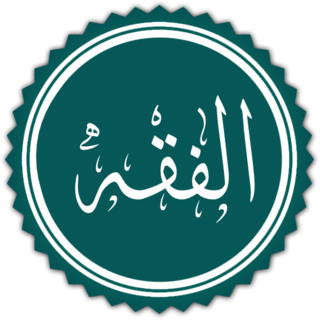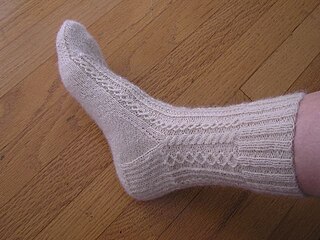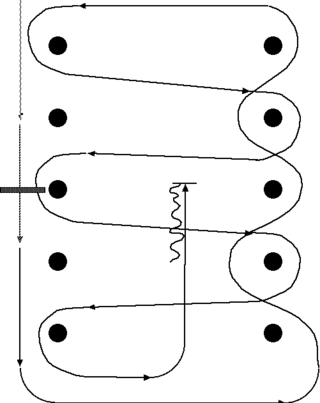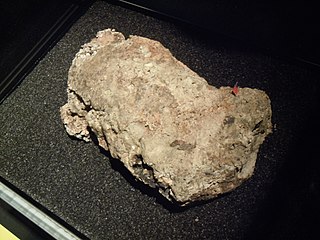
Toilet paper is a tissue paper product primarily used to clean the anus and surrounding region of feces, and—primarily for those with vulvas—to clean the external genitalia and perineal area of urine.

A towel is a piece of absorbent cloth or paper used for drying or wiping a surface. Towels draw moisture through direct contact.

A wetsuit is a garment worn to provide thermal protection while wet. It is usually made of foamed neoprene, and is worn by surfers, divers, windsurfers, canoeists, and others engaged in water sports and other activities in or on the water. Its purpose is to provide thermal insulation and protection from abrasion, ultraviolet exposure, and stings from marine organisms. It also contributes extra buoyancy. The insulation properties of neoprene foam depend mainly on bubbles of gas enclosed within the material, which reduce its ability to conduct heat. The bubbles also give the wetsuit a low density, providing buoyancy in water.

A dry suit or drysuit provides the wearer with environmental protection by way of thermal insulation and exclusion of water, and is worn by divers, boaters, water sports enthusiasts, and others who work or play in or near cold or contaminated water. A dry suit normally protects the whole body except the head, hands, and possibly the feet. In hazmat configurations, however, all of these are covered as well.

Maundy, or Washing of the Saints' Feet, Washing of the Feet, or Pedelavium or Pedilavium, is a religious rite observed by various Christian denominations. The word mandatum is the first word of the Latin Biblical quotation sung at the ceremony of the washing of the feet: "Mandatum novum do vobis ut diligatis invicem sicut dilexi vos", from the text of John 13:34 in the Vulgate. The ceremony commemorates the commandment of Christ that his disciples should emulate his loving humility in the washing of the feet. The medieval Latin term mandatum, came to apply to the rite of foot-washing on the Thursday preceding Easter Sunday, known in English as "Maundy Thursday" since at least 1530.

Wuduʾ is the Islamic procedure for cleansing parts of the body, a type of ritual purification, or ablution. The steps of wudu are washing the hands, rinsing the mouth and nose, washing the face, then the forearms, then wiping the head, the ears, then washing or wiping the feet, while doing them in order without any big breaks between them.
To assume a brace position or crash position is an instruction that can be given to prepare for a crash, such as on an aircraft; the instruction to "Brace for impact!" or "Brace! Brace!" is often given if the aircraft must make an emergency landing on land or water. There are many different ways to adopt the brace position, with many countries adopting their own version based on research performed by their own aviation authority or that of other countries. The most common in passenger airliners being the forward-facing seat version, in which the person bracing places their head against or as close as possible to the surface it is likely to strike, placing their feet firmly on the floor, and their hands either on their head or the seat in front.

Ghusl is an Arabic term that means the full-body ritual purification which is mandatory before the performance of various Islamic activities and prayers. For any Muslim, it is performed after sexual intercourse, before Friday prayer and prayers for Islamic holidays, before entering the ihram in preparation for Hajj, after having lost consciousness, and after formally converting to Islam. Sunni Muslims also perform the ablution before Salat al-Tawba "Prayer of Repentance".

Tayammum is the Islamic act of dry ritual purification using purified (clean) sand or stone or mud, which may be performed in place of ritual washing if no clean water is readily available or if one is suffering from moisture-induced skin inflammation or scaling or illness or hardship.

Etiquette in Japan forms common societal expectations of social behavior practiced throughout the nation of Japan. The etiquette of Japan has changed greatly over the millennia as different civilizations influenced its culture. Modern Japanese etiquette has a strong influence from that of China and the Western world, but retains many of its unique traditional elements.

A wet wipe, also known as a wet towel, wet one, moist towelette, disposable wipe, disinfecting wipe, or a baby wipe is a small to medium-sized moistened piece of plastic or cloth that either comes folded and individually wrapped for convenience or, in the case of dispensers, as a large roll with individual wipes that can be torn off. Wet wipes are used for cleaning purposes like personal hygiene and household cleaning; each is a separate product depending on the chemicals added and medical or office cleaning wipes are not intended for skin hygiene.

The wet-bulb temperature (WBT) is a temperature that can be measured by a thermometer covered in cloth which has been soaked in water at ambient temperature and over which air is passed. At 100% relative humidity, the wet-bulb temperature is equal to the air temperature ; at lower humidity the wet-bulb temperature is lower than dry-bulb temperature because of evaporative cooling.

The anointings of Jesus’s head or feet are events recorded in the four gospels. The account in Matthew 26, Mark 14, takes place on Holy Wednesday, while the account in John 12 takes place 6 days before Passover in Bethany, a village in Judaea on the southeastern slope of the Mount of Olives, where Lazarus lived. In Matthew and Mark, he is anointed by an unnamed woman. In John, the woman is identified as Mary of Bethany, the sister of Martha and Lazarus of Bethany. The event in Luke features an unnamed sinful woman, and is in the northern region, as Luke 7 indicates Jesus was ministering in the northern regions of Nain and Capernaum. The honorific anointing with perfume is an action frequently mentioned in other literature from the time; however, using long hair to dry Jesus's feet, as in John and Luke, is not recorded elsewhere, and should be regarded as an exceptional gesture. Considerable debate has discussed the identity of the woman, the location, timing, and the message.

Trench foot, also known by other names, is a type of foot damage due to moisture. Initial symptoms often include tingling or itching which can progress to numbness. The feet may become red or bluish in color. As the condition worsens the feet can start to swell and smell of decay. Complications may include skin breakdown or infection.

Horse grooming is hygienic care given to a horse, or a process by which the horse's physical appearance is enhanced for horse shows or other types of competition.
Anal hygiene refers to practices that are performed on the anus to maintain personal hygiene, usually immediately or shortly after defecation. Anal cleansing may also occur while showering or bathing. Post-defecation cleansing is rarely discussed academically, partly due to the social taboo surrounding it. The scientific objective of post-defecation cleansing is to prevent exposure to pathogens.

A sock is a piece of clothing worn on the feet and often covering the ankle or some part of the calf. Some types of shoes or boots are typically worn over socks. In ancient times, socks were made from leather or matted animal hair. In the late 16th century, machine-knit socks were first produced. Until the 1800s, both hand-made and machine-knit socks were manufactured, with the latter technique becoming more common in the 19th century, and continuing until the modern day.

Western Riding is a competitive event at American horse shows, particularly those for stock horse breeds such as the American Quarter Horse. It is not to be confused with the general term "western riding," referring to the many forms of equestrianism where riders use a western saddle; instead, it refers to a particular class where the horse and rider complete a pattern that incorporates elements of both reining and trail classes, but requiring horses to perform in a quiet style akin to that of a Western pleasure class. Horses are evaluated on “quality of gaits, lead changes at the lope, response to the rider, manners and disposition." While all three gaits are required, most of the pattern is performed at a lope. Emphasis is placed on the horse's smoothness, even cadence, and precise, clean flying lead changes.

A fatberg is a rock-like mass of waste matter in a sewer system formed by the combination of flushed non-biodegradable solids with fat, oil, and grease (FOG) deposits. The handling of FOG waste and the buildup of its deposits are a long-standing problem in waste management, with "fatberg" a more recent neologism. Fatbergs have formed in sewers worldwide, with the rise in usage of disposable cloths. Several prominent examples were discovered in the 2010s in Great Britain, their formation accelerated by aging Victorian sewers. Fatbergs are costly to remove, and they have given rise to public awareness campaigns about flushable waste.

Human factors in diving equipment design are the influences of the interactions between the user and equipment in the design of diving equipment and diving support equipment. The underwater diver relies on various items of diving and support equipment to stay alive, healthy and reasonably comfortable and to perform planned tasks during a dive.


















